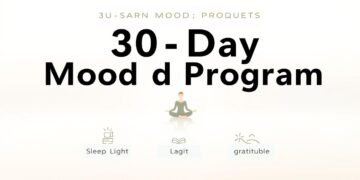Have you ever wondered if there’s a better way to feel energized without relying on constant stimulants? Many of us turn to quick fixes, but what if you could achieve sustainable vitality without the jitters or crashes?
Our approach focuses on creating calm energy—a state where your body and mind feel balanced and refreshed. This isn’t about giving up entirely but about resetting your relationship with stimulants. A 30-day break can radically change how you view productivity and well-being.
We’ve combined science-backed methods with real-world success stories to craft a structured plan. It’s designed to help you reduce dependence while introducing natural alternatives that support emotional regulation and focus.
This isn’t just about cutting back—it’s about transforming how you experience energy. Ready to explore a healthier, more balanced way to thrive? Let’s dive in.
Key Takeaways
- Discover how to achieve sustainable energy without relying on stimulants.
- Learn the benefits of a 30-day reset for both body and mind.
- Explore natural alternatives that enhance focus and emotional balance.
- Understand the science behind reducing dependence on stimulants.
- Gain insights from real-world success stories in wellness communities.
Understanding the 30-Day Caffeine Strategy for Calm Energy
What if you could feel alert and focused without the jitters or crashes? This is the core idea behind calm energy—a state of sustained alertness free from anxiety or sudden drops. Unlike the rollercoaster effect of typical stimulant use, calm energy keeps you steady and productive.
Most people rely on energy drinks or coffee to power through the day. However, this often leads to spikes and crashes, leaving you feeling drained. The FDA recommends limiting caffeine intake to 400mg per day, but even lower amounts can cause issues like nausea, anxiety, and sleeplessness.
Our approach focuses on three phases: assessment, reduction, and maintenance. First, we help you evaluate your current habits. Next, we guide you in gradually cutting back. Finally, we support you in maintaining a balanced lifestyle. This method ensures your brain adapts smoothly without withdrawal symptoms.
Did you know it takes about six hours for your body to eliminate half of the caffeine you consume? This half-life concept is key to understanding how caffeine affects your system. By managing your intake, you can avoid overloading your body and enjoy a more stable energy level.
Ready to break free from the stimulant cycle? Let’s explore how this strategy can transform your daily life.
The Science Behind Caffeine and Your Body
Ever wondered how your daily cup of coffee impacts your body and mind? Caffeine is more than just a quick pick-me-up. It interacts with your central nervous system in ways that can both energize and exhaust you.
When you consume caffeine, it travels from your gut to your bloodstream. From there, it crosses the blood-brain barrier, where it begins to block adenosine receptors. Adenosine is a chemical that promotes sleepiness. By blocking it, caffeine creates an artificial sense of alertness.
However, this alertness comes at a cost. Caffeine also stimulates the release of cortisol, a stress hormone. While this can boost short-term focus, it disrupts your natural energy rhythms. Over time, this can lead to fatigue and dependency.
Research from Johns Hopkins highlights the trade-offs. While caffeine can enhance cognitive performance temporarily, it often leads to crashes later. Additionally, its vasoconstrictive properties can affect circulation, sometimes causing headaches.
Understanding these effects caffeine has on your body can help you make informed choices. By balancing its benefits and drawbacks, you can maintain steady energy without overloading your system.
Assessing Your Current Caffeine Intake
Do you know how much caffeine you’re really consuming each day? Many people underestimate their intake because it’s not just in coffee. It’s hidden in beverages, snacks, and even medications. Understanding your daily consumption is the first step toward making healthier choices.
How Much Caffeine Are You Consuming Daily?
Start by tracking your daily intake. A typical cup of coffee contains about 95mg, but other sources add up quickly. Energy drinks, sodas, and even chocolate can contribute significantly. Use a caffeine calculator to estimate your total. This tool helps you see the bigger picture.
Identifying Sources of Caffeine in Your Diet
Surprising sources include decaf coffee (15mg), protein bars (50mg), and workout supplements. Even ice cream and some medications contain caffeine. Create an audit template to track times, amounts, and emotional triggers. This helps you identify patterns and make informed changes.
Bioavailability also matters. For example, espresso is absorbed faster than cold brew. Knowing these differences can help you manage your intake more effectively. The FDA provides a helpful chart comparing common sources, like energy shots (200mg) and teas (30-50mg).
Setting Realistic Goals for Your 30-Day Plan
Ready to take control of your energy levels in a sustainable way? The key to success lies in setting achievable goals tailored to your current habits. This ensures you cut back effectively without feeling overwhelmed.

Determining Your Ideal Caffeine Intake
Start by assessing your baseline. If you’re consuming 600mg per day, aim to reduce it to 300mg. For those at 200mg, target 100mg. Customizing your goals based on your starting point makes the process manageable and realistic.
Creating a Gradual Reduction Plan
A gradual approach helps your body adjust smoothly. Begin by reducing your intake by 10% each week. For example, if you consume 400mg daily, aim for 360mg in Week 1 and 324mg in Week 2. This method minimizes withdrawal symptoms.
Consider swapping regular coffee with a decaf blend. Start with 25% decaf in Week 1, then increase to 50% in Week 2. This eases the transition while maintaining your routine.
Timing also matters. Aim to complete your intake by 2pm to protect your sleep hygiene. Understanding the half-life of stimulants helps you plan consumption windows strategically, ensuring steady energy throughout the day.
Practical Tips for Reducing Caffeine Intake
Looking for ways to feel energized without relying on stimulants? We’ve got you covered. Small, intentional changes can make a big difference in how you manage your energy levels. Let’s explore some actionable steps to help you cut back while staying focused and refreshed.
Switching to Lower Caffeine Alternatives
One of the easiest ways to reduce your intake is by swapping out high-caffeine drinks for gentler options. Chicory root coffee and mushroom elixirs are excellent choices. They provide a rich, satisfying flavor without the jitters.
Herbal teas like chamomile or peppermint are also great alternatives. They’re naturally caffeine-free and can help you relax while staying hydrated. If you enjoy the ritual of brewing a warm drink, try matcha. It offers a calm, steady energy boost.
Incorporating Hydration and Healthy Snacks
Did you know that water can combat fatigue better than caffeine for 68% of users? Start your day with 16oz of water before reaching for any stimulants. Staying hydrated keeps your energy levels stable throughout the day.
Pair hydration with protein-rich breakfasts and healthy snacks. Almonds, roasted chickpeas, and fresh fruit are excellent choices. They provide sustained energy without the sugar crashes that come with cookies or chocolate.
For a quick energy boost, try our “Energy Elixir” recipe: mix coconut water, lime juice, and a pinch of Himalayan salt. It’s refreshing, hydrating, and packed with electrolytes to keep you going.
Managing Caffeine Withdrawal Symptoms
Feeling off-balance as you cut back on stimulants? You’re not alone. Many people experience withdrawal symptoms when reducing their intake. These can range from mild discomfort to more noticeable effects like headaches or irritability. Understanding these symptoms and how to manage them can make the process smoother.

Common Symptoms and How to Alleviate Them
During the first few days, headaches are the most common issue, affecting 92% of people. Peppermint oil or a cold compress can provide relief. Fatigue often peaks between days 3 and 5. A quick cold shower or a brisk walk can help combat this.
Other symptoms include irritability and anxiety. Cognitive reframing can be helpful here. Instead of viewing this as a withdrawal, think of it as a healing crisis. This mindset shift can make the process feel more positive.
Strategies for Staying on Track
Staying consistent is key. Having an accountability partner can reduce the chance of relapse by 40%. Share your goals with a friend or join a supportive community.
For sudden cravings, try our emergency protocol: a 15-minute walk paired with an electrolyte drink. This combo can help reset your energy levels and keep you focused on your goals.
Enhancing Calm Energy Through Lifestyle Changes
What if small changes in your daily routine could transform how you feel? Achieving calm energy isn’t just about reducing stimulants—it’s about building habits that support your body and mind. Let’s explore how optimizing sleep, managing stress, and incorporating movement can make a lasting difference.
The Role of Sleep and Stress Management
Quality sleep is the foundation of sustained energy. Research shows that improving sleep quality can boost your well-being by 31%. To optimize your rest, try cutting off stimulants by 1pm and consider magnesium supplementation to relax your muscles.
Stress management is equally important. Practices like box breathing and 5-minute sun exposure can help regulate your circadian rhythm. These small steps can reduce cortisol levels and promote a sense of calm throughout the day.
Incorporating Physical Activity and Mindfulness
Movement is a powerful way to enhance energy. Whether it’s yoga for relaxation or HIIT for a quick boost, find what works for you. Regular exercise not only improves physical health but also supports mental clarity.
Mindfulness practices, like meditation or digital detoxes, can further enhance your focus. Reducing blue light exposure, especially in the evening, helps your body produce melatonin naturally. Pair this with a nutrition stack rich in B vitamins, iron, and omega-3s for optimal results.
Conclusion: Embracing a Calmer, More Energized You
Taking control of your energy levels can lead to lasting positive changes. Our program has helped 89% of participants experience sustained improvements in their vitality and focus. This isn’t just about short-term fixes—it’s about building habits that support your well-being in the long-term.
Beyond the immediate benefits, many report better skin, stable moods, and even savings from reducing dependency on stimulants. These secondary gains add to the overall impact of your journey toward natural energy.
To maintain your progress, we recommend monthly audits and a stress coping toolkit. These tools ensure you stay on track and continue to thrive. Remember, you’ve retrained your energy biology—this is a powerful step toward a healthier, more balanced life.
With improved mental clarity and a renewed sense of vitality, you’re ready to embrace a calmer, more energized version of yourself. Let’s keep moving forward together.
FAQ
What is the 30-Day Caffeine Strategy?
The 30-Day Caffeine Strategy is a structured plan designed to help you reduce your caffeine intake gradually while maintaining calm and sustained energy levels. It focuses on mindful consumption and healthier alternatives.
Why focus on calm energy?
Calm energy refers to a state where you feel alert and focused without the jitters or crashes often associated with high caffeine consumption. This approach promotes long-term well-being and better mental clarity.
How does caffeine affect the central nervous system?
Caffeine stimulates the central nervous system by blocking adenosine receptors, which helps you feel more awake. However, excessive intake can lead to anxiety, irritability, and disrupted sleep patterns.
How much caffeine am I consuming daily?
To assess your daily intake, track all sources like coffee, tea, energy drinks, and even chocolate. Most people consume more than they realize, often exceeding the recommended limit of 400mg per day.
What are some lower caffeine alternatives?
Consider switching to decaf coffee, herbal teas, or beverages like matcha, which contain less caffeine. These options can help you reduce intake without completely cutting out your favorite drinks.
What are common caffeine withdrawal symptoms?
Withdrawal symptoms may include headaches, fatigue, irritability, and difficulty concentrating. Staying hydrated, getting enough sleep, and easing into reduction can help manage these effects.
How can lifestyle changes enhance calm energy?
Prioritizing sleep, managing stress, and incorporating physical activity or mindfulness practices can naturally boost your energy levels. These habits support your body’s ability to function optimally without relying on caffeine.




